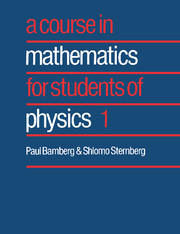Book contents
- Frontmatter
- Contents
- Contents of Volume 2
- Preface
- 1 Linear transformations of the plane
- 2 Eigenvectors and eigenvalues
- 3 Linear differential equations in the plane
- 4 Scalar products
- 5 Calculus in the plane
- 6 Theorems of the differential calculus
- 7 Differential forms and line integrals
- 8 Double integrals
- 9 Gaussian optics
- 10 Vector spaces and linear transformations
- 11 Determinants
- Further reading
- Index
1 - Linear transformations of the plane
Published online by Cambridge University Press: 05 August 2013
- Frontmatter
- Contents
- Contents of Volume 2
- Preface
- 1 Linear transformations of the plane
- 2 Eigenvectors and eigenvalues
- 3 Linear differential equations in the plane
- 4 Scalar products
- 5 Calculus in the plane
- 6 Theorems of the differential calculus
- 7 Differential forms and line integrals
- 8 Double integrals
- 9 Gaussian optics
- 10 Vector spaces and linear transformations
- 11 Determinants
- Further reading
- Index
Summary
In Chapter 1 we explain the relation between the multiplication law of 2 × 2 matrices and the geometry of straight lines in the plane. We develop the algebra of 2 × 2 matrices and discuss the determinant and its relation to area and orientation. We define the notion of an abstract vector space, in general, and explain the concepts of basis and change of basis for one- and two-dimensional vector spaces.
Affine planes and vector spaces
The familiar Euclidean plane of high-school plane geometry arose early in the history of mathematics because its properties are readily discovered by physical experiments with a tabletop or blackboard. Through our experience in using rulers and protractors, we are inclined to accept ‘length’ and ‘angle’ as concepts which are as fundamental as ‘point’ and ‘line’. We frequently have occasion, though, both in pure mathematics and in its applications to physics and other disciplines, to consider planes for which straight lines are defined but in which no general notion of length is defined, or in which the usual Euclidean notion of length is not appropriate. Such a plane may be represented on a sheet of paper, but the physical distance between two points on the paper, as measured by a ruler, or the angle between two lines, as measured by a protractor, need have no significance.
Information
- Type
- Chapter
- Information
- A Course in Mathematics for Students of Physics , pp. 1 - 54Publisher: Cambridge University PressPrint publication year: 1988
